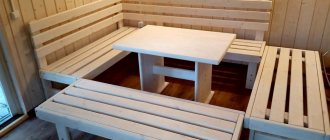Steam generators are widely used for arranging baths, steam rooms, cleaning all kinds of equipment and in the production of alcoholic beverages. Such units allow you to effectively warm frozen pipes and car engines in winter. A homemade unit will function no worse than a purchased analogue if it is properly made at home. Together with the editors of Seti.guru, in today’s review we will look at how to make a steam generator with your own hands for various household needs, and we will also analyze in detail the features of installation, assembly and testing the operation of the unit.
Homemade solid fuel steam generator
Types of steam generators and their use in the household
Regardless of the purpose, the design of steam generators contains a reservoir - a boiler, in which steam is generated and supplied to an external consumer. Based on the type of supply of working fluid (water), it is customary to distinguish between manual types of units and automatic units. Depending on the amount of power consumed, steam generators can be industrial or domestic. For household units, this figure, as a rule, does not exceed 9 kW, and they are connected to a 220 V power supply (industrial units - to 380 V).
Industrial steam generating plant
Depending on the method of heating the working fluid (water), steam generators can be induction, with electrode installations, furnace and electric. The table shows the main features of each type of unit.
Table 1. Types of steam generators and their features
| Type of unit | Image | Description |
| Induction | The water in the device’s tank is heated due to the influence of an electromagnetic field. The equipment allows you to obtain purified and light steam at the output. | |
| Electrode | Inside the reservoir there is an electrode, which is the heating element of the device. The units operate from the mains. As a result of heating water, steam is obtained that is free of harmful impurities and mineral deposits. | |
| Electric | The units are equipped with heating elements of various powers (from 4 kW). Such devices are used for steam rooms. In large areas, steam generators for baths and saunas are used, the power of which exceeds 12 kW. | |
| Pechnoy | Stove heating heats water and releases steam. Coal or wood is used as an energy source. |
In households, factory-made and home-made steam generators are used in arranging steam rooms, as cleaning equipment (washing various surfaces with steam under pressure), and in the manufacture of moonshine stills. The units are also used to heat water pipes and car engines. Watch the video to understand how the steam generator works.
Video “The principle of operation of the steam generator”:
To humidify the air in residential premises, you can make your own ultrasonic steam generator. This device is installed on the surface of the water and generates vibrations of a certain frequency, resulting in the formation of many small drops that rise into the air.
What about the sauna, is it not popular now?
Well why? To each his own! Some people prefer dry steam, others prefer wet steam. Most saunas are powered by an electric stove with an internal and external heating element - stones! And steam from such bath stones will only be produced if you use liquid for steam generation. Most often it is simple water with oils diluted in it. But such steam quickly evaporates due to the high temperatures in the steam room itself.
You can also use a more modernized bathhouse solution by installing a multifunctional installation in the steam room using a stove with a steam generator. Or you can buy a ready-made cool unit, but that’s a completely different story.
That's probably all. Until next time, dear readers. I hope you liked the article, and we will definitely meet again on the pages of this blog! If you rate this information positively, you can share it with your friends on social networks.
Comment, criticize, like. In a word, everything is as usual. Have a nice steam!
Wisdom Quote: Years teach many things that days do not know.
You can also use a more modernized bathhouse solution by installing a multifunctional installation in the steam room using a stove with a steam generator. Or you can buy a ready-made cool unit, but that’s a completely different story.
We invite you to familiarize yourself with: Lighting a bathhouse with your own hands - options and rules for arrangement!
Steam generator Harvia
Steam generator design
A steam generator is a power plant made of a metal casing, inside of which there is a water tank. To make a steam gun for a bath with your own hands, you will need a steam and water pump. In addition, the design of the steam generator must include:
- evaporation chamber;
- temperature sensor;
- heating installation;
- nozzle.
To make a home steam generator with automatic liquid supply, it is necessary to install a pipe outside the structure. This element will be required to connect the unit to the water supply system. You also need to install a valve to drain the liquid.
Advice! The manufacture of such a structural element as an evaporation chamber must be made from materials with high heat resistance. For example, to make a home electric sauna stove with a steam generator, you can use steel or copper.
Manufacturing recommendations
At the stage of developing a drawing of a home-made unit, it is necessary to ensure that the largest possible area of metal water outlets comes into contact with the stove stones. To do this, the pipes must be placed at a minimum distance from the stones.
The simplest device
Even when using a simple steam generator, the bath will have the most comfortable temperature. A home craftsman will be able to make an effective unit with minimal investment. For this, in addition to the stove, you will need the following materials:
- 2 corrugated pipes of larger cross-section;
- porcelain balls that are placed in the stove;
- 2 corrugated pipes of smaller diameter.
First, it is necessary to make holes equidistant from each other with a diameter of 8 to 10 mm in two pipes of a larger cross-section. You will also need to bend both ends of the pipe towards the small holes. These structural elements are placed with the holes facing up on the bottom of the stove opposite each other. Then you need to insert liquid supply pipes with funnels into their bent ends. Having completed these steps, all that remains is to completely fill all the free space of the oven with porcelain balls.
How to make a steam generator for a bath from a gas cylinder with your own hands
A steam generator from a gas cylinder is one of the most popular variations for self-assembly of a steam generator. The metal body is strong enough to withstand high temperatures and steam pressure.
Tools and consumables used in work
When manufacturing a steam generating unit, materials that are resistant to high thermal loads should be used. Among them, stainless steel has proven itself well. The best option for creating a steam generator design is a gas cylinder, since it is made of durable metal and the welds can withstand high pressure. Before starting assembly and installation work, you should prepare plumbing tools. For these purposes you will need:
- electric drill and set of drills;
- roulette;
- fastening elements (screws, bolts);
- circular cutting machine (grinder);
- insulating tape;
- metal scissors;
- a set of keys.
In addition to the listed tools, you will need a welding machine. This equipment is used to ensure strong seams, as well as installation of metal pipes. Consumables should also include sensors for measuring pressure and operating temperature, as well as ball valves. Households often use low-power installations that can be made independently from old household appliances or household items. For example, it could be a steam generator from a flask, an old electric kettle or a pressure cooker.
Selection and preparation of a container for a steam generator
To make your own steam generator for defrosting pipes and other household needs, you should choose a reliable tank for the design. A gas cylinder is ideal for these purposes. As for the size of the container, they should be selected in accordance with the purpose of using the equipment (the amount of steam generated was sufficient to heat the room, clean the car engine, etc.).
Gas cylinder for steam generator
Before starting installation work, for safety reasons, the cylinder should be prepared accordingly. To do this, you need to get rid of its contents by bleeding off the remaining gas. It can be easily removed from the container by unscrewing the valve.
The next step in preparing the tank is to wash the inner surface of the tank (you can use regular dishwashing detergent). The container should be processed until the characteristic smell of propane (gas) disappears. After the cylinder has completely dried, they begin installing the heating elements.
Installation of heating elements
Before you install the heating elements yourself, you should develop a drawing of the steam generator (an example can be seen in the figure). As you can see, a heating element should be installed in the upper part of the tank, which is permanently mounted on a removable lid.
Steam generator heating element
Please note that the heating element must be installed in such a way that if it burns out, replacement can be done without effort. For this reason, it is not recommended to weld heating elements to the structure body.
Expert opinion
Artyom Krikunov
Tool selection consultant at VseInstrumenty.ru LLC
Ask a specialist
“When choosing a heater, it should be taken into account that this structural element must withstand fairly high loads during operation of the unit - from 6.079 Bar. The choice of device based on power should be based on the calculation of 3 kW heating element for every 10 liters of liquid.”
Steam generator connection diagram
As for the assembly of a solid fuel unit, there is no need to make special calculations or install heating elements. Watch the video about the steam generator - it’s quite easy to assemble such equipment yourself, and the cost of consumables will be minimal.
Installation of additional elements
The next stage of self-manufacturing of a steam generator is the installation of additional structural elements that are installed in the upper part of the unit. To secure the automation, as well as the relief (pressure) and filling valve, you should weld small sections of pipes - pipes, in the amount of 4 pieces with threads.
Steam generator pressure gauge
A ball valve is mounted on the side of the structure, which is essentially a liquid level. It opens as soon as the tank is filled with a certain volume of water, and closes when it flows out. This element is installed at a distance of 100 mm from the top point of the unit body.
Features of valve modification
As we have already said, the gas cylinder has a valve made of brass, which should be divided in half. After this, you need to remove the rod and cut the thread to install the ball valve. This design will be required to select steam flows.
Checking the safety of the steam generator
When making a steam generator for hamam, baths and other needs with your own hands, you should check the operation of the unit. For these purposes, at the final stage of assembling the structure, an automatic safety unit should be installed, consisting of pressure gauges that allow monitoring temperature and pressure indicators (they must be connected). The safety unit works as follows: as soon as the internal pressure or operating temperature reaches the limit values, the heating will automatically turn off. A magnetic starter should be included in the electrical circuit of the unit (the retractor coil will be the load). After checking the performance indicators and triggering the safety automatics, the steam generator can be installed for subsequent operation. Below is an approximate diagram of connecting the unit for the steam room.
Selecting a heating element
Suitable container for making the device
This steam device fully meets all the requirements necessary for the implementation of our project:
- it is equipped with a hermetically sealed lid;
- the body of the pressure cooker is strong enough to withstand the pressure required for operation;
- the presence of a special valve makes it possible to “bleed off” excess steam.
After choosing a suitable working container, you will need to decide on the method of heating water in the device used to generate steam.
Note! An electric heater (TEH) is essentially a large boiler used to heat large volumes of water, which you can purchase at any hardware store. But before purchasing it, you should decide on the size and power of the electric heater, which can vary widely.
If you decide to save on a heater, you can disassemble an old-style household electric kettle or electric samovar and use the heating element built into it.
Heating element with a used electric samovar
Note! Using a heating element from a modern electric kettle will require the invention of more complex fasteners. Also, the contacts of such heating elements are not intended for fixing wires to them.
Heating element from an electric kettle
Before assembling the steam generator, it is necessary to accurately calculate the number of devices that ensure the conversion of a given amount of water into steam (to heat large volumes, two or even three heaters may be required).
Heating element for water
Suitable container for making the device
An old pressure cooker, in which the steam generation effect is provided for by its very design, can be used as a body or working container for a future steam generator. (If you don’t have the old appliance, you can purchase a new pressure cooker at a hardware store).
We suggest you familiarize yourself with How to insulate the roof of a bathhouse with your own hands, materials and a step-by-step description of the work
The most convenient and safest way to heat water inside a pressure cooker is to use a special heating device called a heating element.
Heating element with a used electric samovar
Heating element from an electric kettle
Features of assembling a solid fuel steam generator for a home using wood or coal
Assembly of a solid fuel steam generator is much simpler compared to its electric counterpart, and less expensive. The design will require pipes of various diameters. First you need to make a loading tank, for which you can use a pipe with a diameter of 300 mm. It burns coal or wood. It is also necessary to weld a water container that is installed above the firebox. A register pipe and an adapter should be welded to it, through which the steam will be discharged outside. For more information on how to make a steam generator with your own hands, watch the video.
Video “Features of assembling a solid fuel steam generator with your own hands”:
Cedar barrel dimensions
The optimal size of a steam room is directly related to a person’s height, his proportions, the length of his legs and arms, so before you buy or build a cedar barrel with your own hands, you need to determine the parameters of the future product. Conventional steam rooms are built no more than 130 cm high, 70-75 cm wide at the front, and 80-85 cm deep. It would be more rational to plan the dimensions of the phyto-barrel to suit your own dimensions.
To do this, just sit on a chair and measure:
- The vertical distance from the floor to the base of the neck is plus 20 cm. This will be the height of the mini-steam room;
- The maximum size in width at the hips or shoulders with arms down plus 40 cm, you get the frontal dimension of the barrel;
- The distance from the base of the neck to the fingertips of a horizontally extended hand plus 20 cm is the depth of the phyto-barrel in the longitudinal direction.
When planning the shape and structure of the bench, you need to make it adjustable in height so that all family members can use the steam room without any modifications.
We install a steam generator
For obvious reasons, it is not practical to use solid fuel steam generators indoors in bathhouses or steam rooms. For these purposes, electrical units will be required. When installing equipment, you should pay attention to the condition of the hoses - they should be without kinks and have a slight slope. This is necessary for free drainage of condensate.
Welding of bends on the installation
When connecting the power plant to the electrical network, a residual current device should be used. The power of the RCD will be 10-30 mA depending on the type of load and type of room. Please note that the steam generator is a powerful, traumatic electrical installation. For this reason, its installation must be accompanied by the mandatory connection of a grounding loop.
Steam generator installation diagram
Useful tips
The benefits of the bath have been proven many times, but it should be remembered that the steam room produces a physiotherapeutic effect on the body. Therapy involves consultations with doctors and dosing. What is good for a young and healthy person may be harmful for a person weakened by illness or age. Physiotherapeutic procedures can lead to exacerbation of chronic diseases. When visiting a steam room, you should pay attention to your well-being.
If you feel discomfort or pain symptoms, it is better to exercise reasonable caution and reduce the time you spend in the steam room or change the steam parameters towards softening
Despite the simplicity of steam generators or steam cannons made by yourself, do not forget about maintenance, checks, and regular cleaning. The salts contained in the water will settle in the form of scale and impair the operation of the devices.
Open fire stoves require increased fire safety measures. The use of electricity for heating elements is a direct indication of compliance with safety regulations when operating electrical appliances. Incomplete combustion of fuel and smoldering lead to an increased concentration of carbon dioxide, and even to the release of carbon monoxide. Therefore, the removal of combustion products must pass through a cleaned chimney.
The steam room door should open outward and not have locking devices. Switches should be installed inside the steam room to stop the steam generator. It would also be useful to have a signaling device to attract attention in case a person becomes ill and cannot leave the steam room on their own.
How to make a steam generator for a moonshine still – nuances
For this type of steam generator, enameled or galvanized deep dishes are suitable. It is better to use a pressure cooker to make the unit because a heating element is already built inside it, and it is also characterized by excellent tightness. When creating a steam installation for a moonshine still, the unit should be equipped with a safety valve. This element is necessary to relieve pressure inside the container. In addition, you will need to secure the fitting, which is necessary to discharge steam flows.
To control the water level inside the container, you need to install a tube (corrugated metal hose). It is recommended to use a thermometer to control the heating temperature. As for the distillation cube, you also need to install a fitting into this structural element, having previously drilled a hole in its lower part. A steam outlet and a perforated tube twisted in a spiral should be connected to it. Streams of steam are released through it. How to make a steam generator for a moonshine still with your own hands can be seen in the diagram.
Scheme of operation of the moonshine still
When can you start enjoying?
What kind of steam generator is needed for a phyto-barrel and a hammam and do they have anything in common? Of course there is, because both of these “steaming” objects (let’s call them that if you don’t mind) are structured almost identically. Warm steam flows from the steam generator into the hammam room or into the barrel container, saturating them with warm and moist steam, the temperature of which only increases as it is pumped, giving comfort and relaxation to the steam room visitor!
Steam generator canister
So how to build a steam generator for a phyto-barrel with your own hands? To do this, it is enough to prepare the following materials: a flexible metal hose, it is sold in plumbing stores (regular hose for a mixer). It will take approximately 1.5 - 2 meters. Plastic canister with a lid, capacity 5-10 liters.
A metal-plastic pipe with a diameter of 20-32 mm and a length slightly less than the perimeter of the barrel, insulating tape, a metal adapter-splitter (fitting-tee) for the tap. Thermometer with an external electronic display, a wooden barrel with an openable door of the desired size, sealant, screwdriver, drills, heating elements - heating elements, connecting electrical wire with a plug. And don’t forget to have a little patience, as working for results encourages this.
We suggest you familiarize yourself with How to lay slate correctly
Factory phyto-barrel with steam generator
Patience! Very little left! Our design is 99% ready, all that remains is to pour water into the canister, plug in the plug, wait for the water to boil and steam to enter the barrel. Then climb inside, close it with a special shelf on top and a door on the side.
Now enjoy! Just don't forget to look at the thermometer. so as not to overheat. And be sure to monitor the water level in the canister. Otherwise, there will be no luck! Let me note that this is the most basic way to make a homemade sauna steam generator, which can be done without straining.
This is the kind of country mini-hamam we got. And what? We can safely call the phyto-barrel that way. After all, steam baths, including the Turkish bath, are all built according to a similar principle - their design is based on a closed room and steam supply through a steam generator!
We make our own steam generator for heating pipes
As in the previous case, the steam generator must be mobile so that the installation can be moved over a considerable distance. In addition to flexible hoses, electrical cables of similar length will be required to connect the installation to the water supply.
Using a steam generator to defrost pipes
Let's take a closer look at how to make a steam generator for universal purposes out of trash with your own hands. This generator can be used to wash parts of household appliances that cannot be dismantled, for example, air conditioner radiators.
| Illustration | Description of action |
| To work, we will need the simplest things that you probably have lying around in your garage. One of them is an old electric kettle. We take away the most valuable thing from it - the heating element. | |
| We grind the 150 pipe to the required size and trim the edges. | |
| And we insert our “device”. | |
| We grind out an adapter for attaching the heating element. | |
| We attach the rim to the plastic base. | |
| We fix it inside the pipe with ordinary bolts, and make a hole for the electrical wires. Instead of legs, we use hoses. | |
| We weld a sheet on top of the structure, weld a fitting, attach a tee and a tap for filling water, a boiler valve with adjustment and a steam outlet tap with a plug. | |
| We supplement the design with a regular water hose and a gun (we used a regular one for foam). | |
| The steam generator operates from a power outlet and is equipped with a handle like this for mobility. |
The most compact steam room in the world
The use of phytobarrels for personal bathing procedures has now become a mass hobby. The desire to correct deficiencies in the figure, tone up or simply improve health forces people to sit motionless for 10-20 minutes, in an uncomfortable position, shrouded in a cloud of hot steam.
Experts highlight several basic advantages of the phytobarrel - steam room:
- Very simple and safe to use and inexpensive to operate. The phyto-barrel does not require a separate room, does not require a stove, the energy consumption is the same as that of an electric kettle;
- The heat in the phyto-barrel provides quick, uniform and sufficiently deep heating of the tissues, without the risk of heat stroke for the vessels of the head;
- Easy to care for, minimal maintenance.
In fact, this is a simplified version of a steam room for apartment conditions for one person. According to user reviews, the most valuable thing about a phyto-barrel is that you always have your own steam room at hand.
The main reasons for the breakdown of steam generators
Since steam generators are characterized by a simple design and high strength of the materials used, breakdowns of such equipment are quite rare. The main reason for the failure of units is the poor quality of the water used, which causes scale to form. To avoid its formation, appropriate filtering equipment is installed in the water supply circuit. If the water is hard, it is recommended to drain the remaining water from the tank, and also wash the internal surfaces of the structure with acetic or citric acid. After treatment, the unit should be thoroughly rinsed with running water.
Before using the steam generator, it is imperative to check the unit for the presence of working fluid in it. Its absence may lead to burnout of the heating element. Dear readers of the online magazine Seti.guru! Share your experience in the manufacture of steam-generating equipment in discussions with other visitors to our resource, and also offer solutions for its improvement.
What is the difference between a phyto-barrel and a regular bath?
Of course, visiting a small wooden steam room cannot be compared with the effect you get when visiting even the simplest bathhouse. The phyto-barrel has its advantages and disadvantages, but nevertheless, most specialists in restorative medicine consider its use quite useful:
- Increases muscle tone;
- Reduces skin irritation, and in some cases allows you to fight the consequences of injuries, sprains and even colds;
- Reduces swelling of the muscles of the legs and feet, relieves pain in the joints.
For your information! Experts often call a phyto-barrel a sports equipment because of the special love of athletes for this unusual type of steam room.
Advantages and disadvantages
Like any other device, a steam generator for a sauna and bathhouse has advantages, which include:
- complete replacement of traditional wood-burning sauna heaters;
- possibility of operation with electric ovens;
- different operating power - from 2.5 to 15 kW;
- ergonomic body and modern design that goes well with any interior style of the steam room;
- equipped with an electronic remote control system that allows you to control devices from smartphones and tablets;
- full automation of steam generation workflows;
- possibility of adjusting the main parameters of steam generation.
However, such a unit has significant disadvantages:
- the high cost of finished devices and components for repairs;
- prone to breakdowns;
- dependence on electricity;
- susceptibility to power surges in the operating network.











